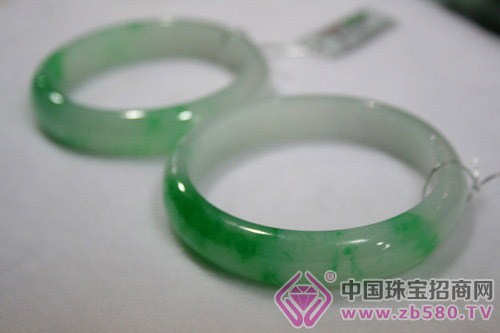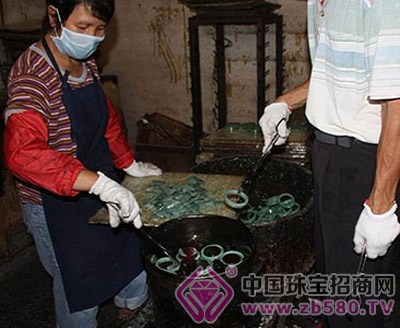About "Artificial Jade"

Artificial jade, refers to the ordinary jade stone with loose texture as raw material, processed by acid pickling, injection molding, dyeing, etc. to form B goods or C goods jade. Artificial jade is cheaper than natural A-carved jade. Due to the use of some chemicals in the processing, it can cause skin health, redness and other health hazards.
What is artificial jade
Artificial jade, also known as artificial treatment of jade, generally B goods, B + C goods and C goods three. In the jewelry industry, Jade has A, B and C goods. Naturally produced, not manually processed, called A goods; after strong acid soaking, and then filled with glue for processing, called B goods; after artificial dyeing, it is C goods.
The practice of treating poor quality jadeite into B goods and C goods originated in the 1980s and has a certain buying market in the private sector, which is related to the Chinese consumer demand. Because B and C goods look good, and consumers who don't have enough money to buy high-end jade jewelry know that they are manually processed, they are willing to buy.

Artificial jade processing technology
B goods
The processing of B-Jadeite generally consists of two steps:
1. Bleaching to remove impurities.
Soak the jade with concentrated acid bleach for several hours to several months, remove the impurities, do the yellowing treatment, make the ground color pure, and achieve the purpose of not seeing brown or grayish black.
2, injection glue.
A colorless epoxy tree finger was injected with a high pressure vacuum to reinforce the jade structure which was destroyed by pickling and bleaching. Glue polymers are injected between grains or gaps to fill, brighten, polish, and reinforce. However, there are also materials such as lead glass, oil, and wax. The jade treated in this way is called B goods. Although the B goods increased the appearance of the jade, it destroyed the original structure of the natural jade, and the effect was kept short. This treatment has become the biggest deception in the jade trade.
B+C goods
That is, in the above bleaching and injection molding process, a dye is added and the jade is processed together. There is also a so-called bleaching and injection dyeing jade, referred to as "bleaching jade".
C goods
That is, the traditional method is used to heat the jadeite to a certain temperature and then put it into the ammonium dichromate solution, so that the white jade is dyed into a green artificial treatment product. Commonly known as "ç‚色玉", it is significantly different from the natural jade color, generally the most common in green or purple, called "dyed jade."

Artificial jade features
1. In the process of pickling, the artificial jade washes away the trace elements such as iron in the jade, so that the transition band between the green and the white is lost. The green is not moist, the white is white, the green is green. The two are distinct. Unlike pure natural jade, there is a layer of halo between the green and white, that is, transitional yellowish green or yellowish gray.
2, the jade of artificial jade, regardless of B goods, C goods, B + C goods, its color is unnatural, sluggish, evil. When the C goods were observed with a magnifying glass, it was seen that the networked dye was present.
3, the green floating of the treated product, look at no color roots, the green edges are uneven, and become flocculent. Unlike the natural jade green, the nails are as heavy as the nails, and the roots are strong and powerful. The green color is silky, soft and beautiful.
4. In addition to jadeite, the natural jadeite contains a small amount of chromite, feldspar, amphibole, mica, etc. These minerals have different degrees of corrosion under acid soaking. Therefore, the treated product was observed with a magnifying glass, and the surface of the crystal was disordered, and the undulations were like fish scales, with cracks in the turtle and trachoma. Even with glue backfill, there are still dents visible.

The danger of artificial jade
Folk rumors, long-term wear of pickled, glued, dyed and other processes after the treatment of B goods, C goods jewelry will cause cancer, in this, many jade industry insiders said that I have not heard of who wear cancer, but because The chemicals used in the processing will remain in the jewelry, which is definitely not good for the human body.
1, some people may have skin allergies, inflammation, redness and swelling.
Only a small amount of sulfuric acid and hydrochloric acid used for pickling will remain on the jewelry; the curing agent is mainly a basic diamine, a polyamine, and an acid anhydride; the dye is mainly an organic dye. These chemicals are basically low-toxic substances, and long-term exposure can cause damage to the skin, but it does not cause cancer.
2, the artificial treatment of jade in the process of a large amount of epoxy resin, the main component is the epoxy resin formed by bisphenol A and epichlorohydrin, poured into the jade and then added curing agent solidified, hard and brittle, color Transparent and slightly yellow, similar to rosin, heat resistant, corrosion resistant, insoluble in water. Epoxy resin is often used as a binder and is widely used in aviation, vehicle and ship, railway, construction, medical and other fields, and no one suffers from cancer.
3, on the wax, even if the A goods are carved out will use wax, can make the jewelry beautiful and beautiful. The wax is mainly made of paraffin or beeswax, which has little effect on the human body.
Don't know what to wear at home?
You should try these clothes on
It's such a wonderful thing to wear comfortable clothes at home with your family
SHAOXING LIDONG TRADING CO.,LTD , https://www.suejiangarments.com